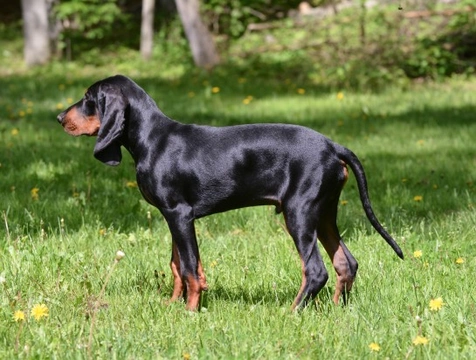
More information on the black and tan Coonhound
The black and tan Coonhound is an American breed of dog that was developed from crossing the Bloodhound with the black and tan Virginia Foxhound, and has a superior sense of smell that assists the dog in trailing and “treeing” prey such as raccoons. Treeing is an American term for a very specific hunting behaviour in dogs, which involves the dog pursuing prey while directing them towards a tree, and then chasing the dog up the tree and remaining beneath it to pin the prey, while awaiting the arrival of the hunter.
The breed is black and tan in colour with a similar pattern distribution to the Doberman pinscher, with short, straight fur. They have long, wide and pendulous ears, hazel or brown eyes, and are fit and muscular in appearance, weighing up to 75lb and standing up to 70cm tall at the withers.
As a noble, large and handsome dog that has many potential working applications, the black and tan Coonhound is popular in America as both a working dog and a pet, and can also be found, albeit in smaller numbers, within the UK. If you are wondering if the black and tan Coonhound makes for a good domestic pet and want to find out more about them, in this article we will cover some of the most frequently asked questions about the black and tan Coonhound in more detail. Read on to learn more.
What is their temperament like?
The black and tan Coonhound is most widely kept as an outdoors, working dog, and has not traditionally been widely kept indoors as a pet. However, they are very adaptable dogs, and adapt well to indoor life, being calm, mellow and amiable when housed within a domestic situation.
They have superior levels of endurance and are very dogged when something catches their attention, but they do enjoy the company of people and try hard to please their handlers when working. They are rarely aggressive, are well behaved indoors, and are not particularly challenging to keep within the home. They bond strongly with their owners and like to be beside them at all times, and accompany them about their daily business.
How much exercise do they need?
As a working dog breed first and foremost, the black and tan Coonhound is used to living a fit and active lifestyle, and they will not thrive within a sedentary exercise regime. When outside they can run around and work for many hours without tiring, but they do not require particularly high energy exercise, and are contented with jogging, walking and rambling, or simply exploring off the lead. They do need to spend several hours outside and exercising each day, and so may not be well suited to families that are out a lot, or that do not live a particularly outdoorsy lifestyle.
Are they easy to train?
As a scent hound with a very highly attuned sense of smell, the black and tan Coonhound is most amenable to training when allowed to hone their hunting and trailing instincts, and are well suited to all types of scenting work. They are bold, confident and clever, but may become stubborn if bored, and so plenty of variety in training is essential in order to keep the black and tan Coonhound interested in what is going on! They require clear directions and lots of praise, and are capable of learning new skills throughout their lives.
Do they have a strong prey drive?
It is certainly fair to say that the black and tan Coonhound has a strong tendency to hunt, using their sense of smell to seek out and pursue prey. This means that they are almost always on the lookout for a trail to pursue, and require good supervision when outside of the home to keep them from taking off after a trail, or potential prey!
Are they good with other animals?
The black and tan Coonhound generally gets on well with other dogs when properly socialised from a young age, and they can potentially live alongside of cats too providing that they are well trained not to hunt the cat, a feat that should certainly be within reach of most owners.
Are they well suited to domestic life?
The black and tan Coonhound is independent and strong willed, requiring clear, strong leadership and lots of variety. They are renowned for being tolerant, gentle and affectionate with children, and love playing with kids, but on their own terms!
While they often bond well with children and like to play with them when it suits, their independent temperaments and need for strong direction and leadership means that they make better pets for adult owners than as a dog intended to be largely handled by older children in order to teach them about dog ownership.



